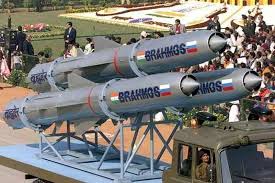
In a significant stride towards enhancing India’s defence capabilities, Defence Minister Rajnath Singh virtually inaugurated the BrahMos Aerospace Integration and Testing Facility in Lucknow on Sunday. This state-of-the-art facility, developed under the Uttar Pradesh Defence Industrial Corridor, will play a pivotal role in assembling and testing the supersonic BrahMos cruise missiles, as well as producing lighter, next-generation (NG) variants designed to substantially boost India’s precision-strike abilities from land, sea, and air.
BrahMos: A Game-Changer in Modern Warfare
BrahMos, a universally acclaimed precision-strike missile, is capable of being launched from land, sea, and air platforms. Known for its speed, accuracy, and versatility, BrahMos operates in all weather conditions and is designed for day-and-night missions. With over 100 successful test firings, the missile has established itself as a game-changer in modern warfare. Its multi-role, multi-target, and multi-platform capabilities make it an invaluable force multiplier on the battlefield.
The BrahMos missile can hit targets with high precision at ranges of 290 to 400 km, flying at a blistering speed of Mach 2.8 (around 3,430 km/h). What sets it apart is its “fire and forget” guidance system, ensuring high accuracy in striking targets, making it a formidable weapon in India’s arsenal.
A Significant Boost to Defence Production
The new BrahMos production unit in Lucknow is set to manufacture between 80 to 100 supersonic BrahMos missiles annually. In the future, the facility plans to scale up production to 100 to 150 next-generation variants every year. These advanced variants, significantly lighter at 1,290 kg (down from 2,900 kg), will enable fighter jets like the Sukhoi Su-30MKI to carry up to three missiles instead of just one, greatly enhancing India’s air-strike capabilities.
This new facility is part of BrahMos Aerospace, a joint venture between India’s Defence Research and Development Organisation (DRDO) and Russia’s NPO Mashinostroyeniya. The Lucknow unit is being developed with an investment of ₹300 crore on 80 hectares of land generously provided by the Uttar Pradesh government.
Infrastructure and Strategic Materials
Beyond missile production, the facility will house the Titanium and Super Alloys Materials Plant, officially called the Strategic Materials Technology Complex. This plant will produce aerospace-grade materials essential for advanced defence systems, further enhancing India’s self-reliance in defence manufacturing.
Additionally, a separate Defence Testing Infrastructure System (DTIS) will be established at the site to provide a dedicated hub for testing and certifying a wide range of defence products.
Strategic Importance of the Uttar Pradesh Defence Industrial Corridor
The BrahMos production facility is part of the larger Uttar Pradesh Defence Industrial Corridor, which spans six key nodes: Lucknow, Kanpur, Aligarh, Agra, Jhansi, and Chitrakoot. This corridor, announced by Prime Minister Narendra Modi during the 2018 Global Investors’ Summit, marks a crucial step towards strengthening India’s defence manufacturing ecosystem. Uttar Pradesh joins Tamil Nadu as the second state to establish a dedicated defence corridor, signaling a significant investment in the nation’s defence infrastructure.
A Timeline of Rapid Development
The foundation stone for the BrahMos Aerospace Integration and Testing Facility was laid in 2021, and in just three and a half years, the entire project has been completed. This rapid construction highlights India’s commitment to strengthening its defence capabilities and the efficiency with which key defence infrastructure is being developed.
Future of India’s Defence Industry
As the BrahMos production facility begins operations, it is expected to contribute significantly to India’s strategic defence initiatives. With its advanced manufacturing processes, the unit will ensure the timely production of one of the world’s most advanced precision-strike missile systems, reinforcing India’s position as a leading player in global defence.
Sources By Agencies




